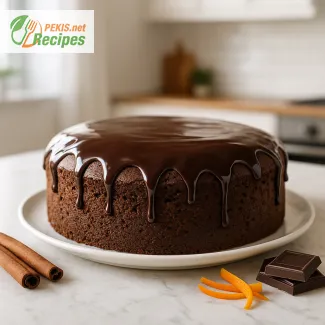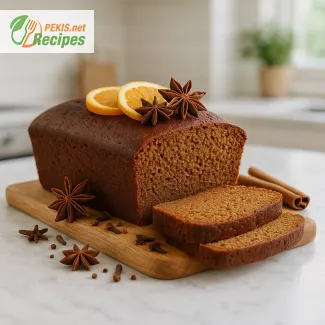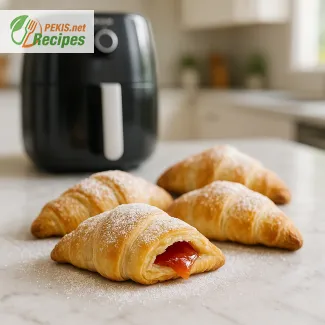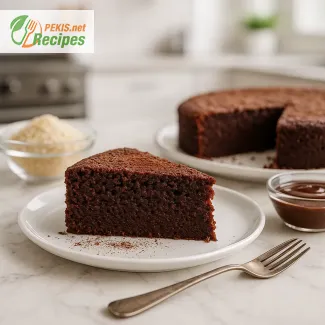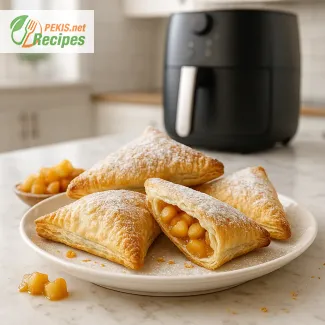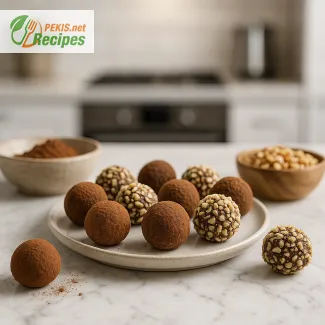Silky Fruit Replica Cake delivers 6 servings of stunningly realistic fruit-shaped desserts in just 40 minutes total (prep 40, cook 0). Crafted from smooth white chocolate mousse, vibrant peach and strawberry purées, and a light sponge base, each mini cake mimics real fruit with edible color glazing and cocoa butter shine. The result is a deceptively lifelike creation—creamy inside, glossy outside, and perfectly portioned for elegant plating or celebration tables. Best stored chilled up to 2 days, it maintains its texture and vivid hues, making it a showpiece dessert that’s as artistic as it is indulgent.
Creating desserts that blur the line between art and food has always been part of my kitchen philosophy. Years of working with textures, glazes, and fine details led to this Fruit Replica Cake, where technique meets imagination. The process demands patience—tempering, layering, glazing—but the payoff is pure visual and sensory pleasure. Each step builds precision, from shaping the mousse to achieving that perfect fruit sheen.
PEKIS – a professional chef and recipe developer with more than 25 years of experience in cooking and baking, specializing in European and international cuisine.
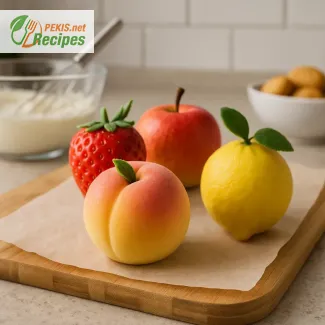
Realistic Mini Fruit Cakes – An Artistic Pastry Creation
Lifelike Desserts with Mousse, Glaze, and Natural Fruit Essence
Every curve, shade, and gleam of a Fruit Replica Cake tells a story of craftsmanship and balance. These tiny masterpieces are shaped like real fruit—peaches, lemons, apples, or strawberries—but inside lies a delicate composition of light mousse, thin sponge base, and fruit purée infused with vanilla and citrus zest. The glossy coating mirrors the natural skin of each fruit, creating an illusion that delights both eyes and palate. It’s a dessert that blends technical precision with artistic expression, where every layer contributes to an experience of texture, color, and taste harmony.
Beneath the vivid glaze, the mousse structure plays the main role. Using white chocolate, heavy cream, and natural purées, it becomes airy yet stable, ready to hold the perfect fruit shape. The base—often a sponge or soft biscuit—anchors the dessert, adding structure and contrast. A touch of lemon or strawberry essence enhances freshness, while the cocoa butter glaze ensures a mirror-like finish that captures every detail.
The story behind the Fruit Replica Cake
The concept of creating desserts that mimic real fruit originates from the French pâtisserie tradition, where illusion became art. Inspired by the philosophy of trompe-l’œil—to deceive the eye—modern pastry chefs turned this into an edible sculpture movement. Chefs like Cédric Grolet elevated it to haute cuisine, crafting each piece by hand to achieve perfect realism. Over time, the technique spread across Europe and beyond, inspiring bakers to merge flavor, texture, and art into a single creation that celebrates nature through imitation.
Why you’ll love this dessert
- Visually striking, with lifelike fruit details.
- Delicately balanced flavors, combining mousse and purée.
- Elegant presentation, ideal for special occasions.
- Customizable fruit profiles – create your own mix of citrus, berry, or tropical notes.
- Perfect texture – soft mousse meets gentle sponge base.
- Professional-level appearance, achievable in a home kitchen.
The sensory balance of flavors and textures
The secret lies in contrasts: the cool, creamy mousse versus the warm sweetness of sponge, the shiny glaze against the matte fruit detail. Each bite unfolds gradually—first smooth and velvety, then light and fruity. The use of real fruit purée provides authenticity, while vanilla and cocoa butter bring depth. Every step demands precision: correct temperature for melting chocolate, gentle mixing to preserve air, and controlled cooling to avoid condensation. These nuances define the success of each edible illusion.
Storage and make-ahead preparation
A major advantage of this dessert is its flexibility. The cakes can be frozen for up to two weeks before glazing or chilled for 48 hours after finishing. Once defrosted, they retain structure, sheen, and flavor without compromise. To serve, allow a 10–15-minute rest at room temperature so the mousse softens slightly, releasing its aroma and creaminess. Proper storage in an airtight container prevents odor absorption and moisture loss, keeping each piece pristine.
Creative variations
- Citrus edition: Combine yuzu, lime, and orange purées for a bright, tangy balance.
- Chocolate harmony: Replace white chocolate with milk chocolate for depth and warmth.
- Berry elegance: Create raspberry or blueberry versions with natural pigments.
- Vegan option: Use coconut cream and agar-agar instead of dairy and gelatin.
- Miniature set: Mix multiple fruits on a platter for a colorful centerpiece.
Modern pastry illusion art and flavor design
The culinary illusion trend represents a new language of pastry art, where food becomes storytelling. Techniques like airbrushing, color layering, and mirror glazing require precision and creativity. At the same time, the composition must respect balance: natural fruit acidity meeting creamy sweetness. Each piece acts as a micro sculpture, bridging the line between realism and indulgence.
Mastering this dessert teaches more than decoration—it refines understanding of how temperature, texture, and timing define flavor experience. Whether served at fine dining events or as a home experiment, it captures attention and admiration through authenticity and detail.
You can also explore these complementary recipes for creating your own fruit-inspired desserts:
Discover the Moist Fruit Cake Base – The Perfect All-Purpose Dessert Foundation that provides an ideal sponge structure for layered treats.
For a delicate foundation, try the Easy Sponge Cake Recipe – Perfect Base for Layer Cakes, designed to pair with mousse and glazes.
To elevate natural flavor tones, prepare the Easy Strawberry Puree Recipe – Fresh or Frozen (No Sugar Added) for authentic, fruit-based sweetness.
Technical harmony in pastry sculpture
Every successful Fruit Replica Cake reflects precision and patience. The combination of temperatures, timing, and textures defines not only the look but also the emotional impact of the dessert. The controlled shine of the glaze, the air-light mousse interior, and the gentle sponge base create an illusion that goes beyond visual trickery—it’s a celebration of culinary craftsmanship.
This dessert bridges art and gastronomy, serving as a symbol of creativity grounded in technique. Through careful layering, real fruit notes, and artistic finish, it captures the essence of what modern patisserie strives for: flavor, form, and perfection in one bite.
- Prepare the mousse base:
Heat the heavy cream gently until warm but not boiling. Add white chocolate and stir until smooth. Dissolve gelatin in cold water and let it bloom for 5 minutes, then mix it into the warm cream-chocolate mixture until completely melted. Add vanilla extract for aroma and whisk until silky. - Add fruit purées:
Divide the mousse base into portions for each fruit flavor. Mix peach purée with a hint of lemon zest in one portion, and strawberry purée in another. This creates natural flavor distinction and realistic color tones. - Fill molds:
Pour each mousse flavor into silicone molds shaped like fruits. Place a small circle of sponge cake at the base of each mold. Freeze for at least 4 hours or until completely firm. - Prepare glaze and cocoa butter spray:
Melt the neutral glaze with cocoa butter and divide it into sections for coloring. Add edible powders to create lifelike shades for peach, lemon, apple, and strawberry. Keep each color warm but not hot, around 30°C (86°F). - Coat and assemble:
Remove frozen mousse fruits from the molds and place them on a wire rack. Glaze or airbrush them evenly for a natural appearance. Attach mint leaves or small chocolate stems for a realistic touch. - Chill and serve:
Transfer the decorated cakes to the refrigerator for at least 30 minutes before serving. The texture should be smooth and soft, with the illusion perfectly preserved.
FAQ questionHow do I make the fruit shapes look realistic?
Use silicone fruit molds, fill with well-aerated white-chocolate fruit mousse, and freeze solid. For the finish, apply a neutral glaze for gloss or a cocoa-butter velvet spray for a peach-skin effect. Layer two to three color tones (light → mid → accent) with an airbrush to mimic natural gradients and add tiny chocolate stems or mint leaves for realism.
FAQ questionWhat’s the best mousse texture for clean unmolding?
Aim for a light but stable mousse: dissolve gelatin completely in warm cream, emulsify with melted white chocolate, then fold in cold fruit purée. Chill the base to 20–25°C before molding. This balance of fat, gelatin, and water gives a smooth set that unmolds without cracks and still melts on the palate.
FAQ questionCan I make the cakes ahead and freeze them?
Yes. Assemble in molds and freeze up to 2 weeks in an airtight box. Glaze or velvet-spray straight from frozen to prevent drips and dull spots. After finishing, store chilled for 24–48 hours. For serving, temper 10–15 minutes at room temperature so the mousse softens and aromas bloom.
FAQ questionHow do I choose colors that stay vibrant but natural?
Use oil-soluble colors for cocoa-butter sprays and water-soluble gels for neutral glazes. Mix warm and cool undertones (e.g., lemon yellow + a dot of green, peach pink + apricot) to avoid flatness. Keep working temperatures 28–32°C so pigments disperse evenly and the finish remains shiny and stable.
FAQ questionWhat base layer works best inside the fruit?
A thin genoise or joconde disk provides structure and prevents sogginess. Lightly brush with fruit syrup for flavor, but keep it thin so the mousse remains the hero. For crunch contrast, add a praliné feuilletine insert—just enough for textural snap without overpowering the fruit.
FAQ questionHow can I make a vegetarian or dairy-free version?
Swap gelatin for agar-agar (bloom and simmer to activate), and replace dairy with coconut cream or cashew cream blended with cacao butter for body. Choose a dairy-free white chocolate and a gluten-free sponge if needed. The key is maintaining fat + gel balance so the mousse sets and slices cleanly.
FAQ questionWhy does condensation ruin my glaze and how do I prevent it?
Condensation forms when warm air meets very cold cake, dulling shine and causing streaks. Work in a cool, low-humidity kitchen, glaze between 28–32°C, and move cakes directly from freezer to glazing. After finishing, refrigerate uncovered for 10–15 minutes to set the surface before boxing.
Precision, patience, and artistry come together in the Fruit Replica Cake, transforming a simple mousse dessert into a culinary illusion. Every detail—the color, the texture, the gloss—contributes to an experience that delights both sight and taste. Beneath the lifelike exterior lies a soft, creamy balance of white chocolate, fruit purée, and light sponge, blending freshness with indulgence in every bite.
Each element of the process reinforces the connection between technique and creativity. Controlling temperature, timing, and texture determines whether the final dessert shines or dulls. When executed carefully, the result captures that delicate line between real fruit and edible art, proving that precision in pastry is as much about intuition as it is about skill.
The Fruit Replica Cake stands as more than a dessert—it’s an expression of craftsmanship, flavor harmony, and modern culinary design. Whether prepared for a celebration or to refine professional techniques, it invites admiration before tasting. The combination of natural fruit aromas, smooth mousse, and visual perfection leaves a lasting impression that embodies the essence of fine patisserie.
Served chilled, its structure holds firm while the mousse melts effortlessly on the tongue. Each piece feels unique, personal, and carefully crafted—a reminder that culinary art thrives in the details. With practice and curiosity, this dessert becomes a statement of both elegance and innovation, inspiring anyone who values the beauty of flavor meeting form.
Allergens present in the recipe:
- Milk
- Gluten (from sponge cake)
- Soy (possible traces in white chocolate)
To make it allergen-free:
- Replace white chocolate with dairy-free vegan chocolate.
- Use gluten-free sponge cake or almond-based biscuit for the base.
- Substitute gelatin with agar-agar for a plant-based alternative.
- Vitamin A: 120 µg – supports healthy vision and skin.
- Vitamin C: 25 mg – boosts immunity and collagen production.
- Calcium: 60 mg – maintains strong bones and teeth.
- Iron: 0.7 mg – supports oxygen transport in blood.
- Magnesium: 25 mg – helps with muscle function and energy metabolism.
- Flavonoids (from strawberries and peaches): 50 mg – help neutralize free radicals.
- Carotenoids (from peach purée): 20 mg – support skin and eye health.
- Polyphenols (from fruit purées): 40 mg – contribute to anti-inflammatory benefits.
- Vitamin E: 1 mg – protects cells from oxidative stress.
